
This week I am delighted to say we are putting we are adding a book on the map to Wales – Ireland we need your entries urgently and I know that there are loads of fantastic authors and bloggers in Ireland!!
Anyway Wales, or to be precise, Pembrokeshire is the setting for Thorne Moore’s book A Time For Silence which Booker Talk nominated for a spot on the map. It is always particularly lovely to feature a blogger I’ve followed for many years, and I was thrilled that Booker Talk kindly offered her time to post here. I think you’ll agree that Booker Talk’s love of the region shines through in this joint post along with that of the author of this superb novel. Thorne Moore kindly supplied the photos, I particularly love the one of the cottage, the inspiration for the novel!
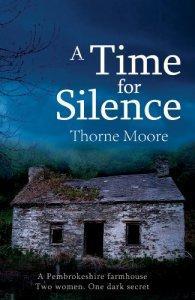
Although I lived on the border of England and Wales as a child and spent many holidays in Wales, I’m not entirely sure I’ve ever visited Pembrokeshire so I’m handing the geography part in the capable hands of Booker Talk.
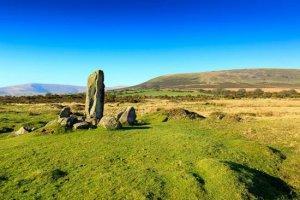
Today The Book on the Map is set in Pembrokeshire, Wales. For those of you who were not paying attention in your geography classes, this area is to the south west of the UK, just across the sea from Ireland. It’s renowned for the beauty of its coastline with high cliffs teeming with wildlife dropping down onto small bays of golden sand, while inland the Preseli Hills (where the stones used to build Stonehenge were quarried) give way to verdant valleys. If the scenery looks a little familiar it’s because Pembrokeshire has been used extensively as a film location – most recently by the team behind Harry Potter and the Deathly Hallows. Pembrokeshire is significant too for its historical connections – this was where Henry Tudor landed as he began his campaign to seize the crown and establish the Tudor dynasty.
This is where I go when I want an escape from a frantic work schedule. I’ve walked the coastal path, explored the many ruined castles dating from the 12th century and savoured the local produce. And then I go home refreshed.
But before I get carried away extolling this part of my country and sounding too much like a sales rep for the Pembrokeshire tourist board, lets get back to the book.
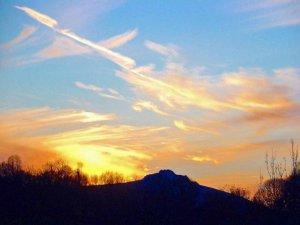
A Time for Silence traces a woman’s quest to uncover the history of her grandparents Gwen and Jack who once lived in a remote farmhouse in Pembrokeshire. Sarah’s romanticised view of their lives is however turned upside down the more she delves into the past. Interest turns into an obsession which threatens to destabilise this woman who is already struggling to deal with feelings of guilt about the death of a friend. The novel is told as a dual-time narrative which switches between the mid twentieth century and present day. It’s the debut novel by Thorne Moore.
Although originally from the London area, Thorne Moore’s connection with Wales dates from her time as a history student at the University of Wales in Abertystwyth. She now lives in a Victorian farmhouse in Pembrokeshire in west Wales where she divides her time between writing and her craft business.
Let me hand you over to Thorne to tell us about herself and her love of Pembrokeshire
My mother’s family comes from Pembrokeshire, but I grew up in Luton, which is loud, busy, crowded and industrial. Luton always felt like a town which didn’t care to acknowledge history. Anything old was swept away, buried under rampantly modern development.
When I moved to Pembrokeshire in 1983, the contrast couldn’t be greater. Here, history is inescapable. The land wears it, visibly. The hills are littered with Neolithic, Bronze Age, Iron Age, Dark age legacies. There are castles, cathedrals, and ruins in plenty, as well as the site of the last invasion of Britain (1797). In 1983, when I moved here, history was a living thing. My new local paper was dedicated to magistrates’ court reports and chapel funerals, with a full list of floral tributes. The High Streets had a hardware store, where washers and cup hooks were carefully counted out from rows of tiny oak drawers, and a dimly lit haberdashers, where a little old lady in mittens would emerge from behind curtains to exhibit her delicately hand-embroidered handkerchief collection. Cafés shut for lunch. The town became impassable on cattle-market day. I had stepped at least fifty years back in time.
I had also moved fifty miles away from anywhere. From Carmarthen, you’re on the slip road to the M4 motorway; Cardiff; London; the world. But first get to Carmarthen, across hills on minor roads blocked with snow in winter and silage wagons in summer. Even now, in 2017, there’s a sense of timeless isolation in North Pembrokeshire, although nowhere is really isolated any more, thanks to the internet. We do have broadband. Very slow broadband. We do have mobile phones, which can, sometimes, pick up a signal of sorts. The little shops have been replaced by supermarket chains. But even now there is still a sense of living in a closed world.
The isolated nature of North Pembrokeshire inspired my first novel, A Time For Silence. Can a secret could be kept by a community? I was told of one such secret, shared and kept for decades. How could it have been kept a secret, I wondered? It wouldn’t have been possible on the housing estate where I grew up, but here, where rural parishes could keep themselves to themselves, of course it had been possible.
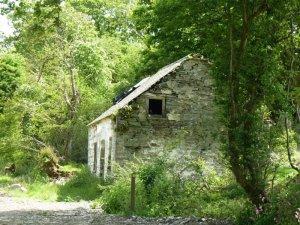
Another inspiration was an abandoned cottage. They were two a penny here until the demand for holiday cottages exploded. This one was just 100 yards from my garden, and almost impossible to reach without sinking in mud or being shredded on brambles. Today it is being restored, but when I first came upon it, it was forgotten, deep in trees. Peering through the windows, I could see two small rooms, with an inglenook fireplace in which a rusty old kettle had been abandoned, and a collapsed upper floor. Who had lived there? What life had been like? The inspiration was doubled when I considered that my maternal family had come from the area and had probably lived in something very similar.
My book also makes use of another inescapable aspect of the area. Language. Pembrokeshire is sometimes called Little England Beyond Wales, but that is the south of the county, which has been Anglicised for centuries. The north has remained defiantly Welsh.
My present-day heroine, Sarah, had Welsh grandparents, but she is totally English and doesn’t speak a word of their native language. She comes across the cottage where they’d lived, and discovers a dark secret which she is determined to investigate. She imagines their lives to have been a quaint, rural idyll. It is because she is so utterly separated from them by time, culture, economics, language, religion and social expectations, that the truth eludes her when she delves into her family history.
I think, perhaps, I could have set the story in isolated communities elsewhere – in the fens, perhaps, or up on the Pennines, but I would not have had the extra mystification of language to add to the mix. It helps make this area ideal for my speciality, domestic noir. It’s all very domestic. And it can be very noir.
It seems the plot of A Time for Silence was inspired by a real life event. Can you tell us more about that?
There were two events, and going into them in detail would give the whole plot away. I was told of something that had happened, years ago, at a cottage in the vicinity. Everyone knew what had happened. Everyone, including the police, knew who was responsible, but nothing was done. No action was taken. I was intrigued by the idea of a tight little community closing ranks so completely. Whether the story is true or not, I have no idea. I was trying (and failing) to find some record of it in old copies of the local newspaper, when I came across another story – a court report from the 1950s, in which a young girl was on trial for the heinous crime of attempting suicide. When the magistrates asked her why she had done such a wicked thing, she “made allegations of a serious nature,” which everyone decided, on the surface, to disbelieve. She was packed off to Approved School in punishment, but between the lines I picked up a sense that by removing her from her home, the authorities were really trying to address a problem without openly acknowledging it. I wanted to shout “Listen to her!” But they couldn’t, because it would undermine their world.
There is a very strong sense in your book of the small rural community you call Cemaes. This is where the grandparents had their small-holding. Does Cemaes exist or is a product of your imagination?

If you drive north, from Haverfordwest, over the Preseli hills, you come to a high pass from which, suddenly, you see North Pembrokeshire, all tiny ancient fields, forests, moorland and deep valleys, with scattered hamlets and miniature marooned churches. It’s a very unique place, quite different to the land south and east of the hills and I call it Cemaes because why not? It has a suitably antique feel to it. Cemaes – or Cemais, or Kemys – was an old Hundred, or Cantref in North Pembrokeshire and there is still a Cemaes headland.
How important was the setting to you in the novel? For example did you consciously try to draw attention to the location in certain scenes, or was it more a background inspiration for you?
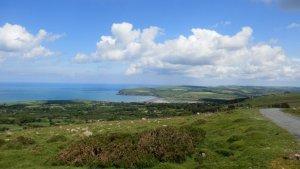
The setting was important because it is so isolated, so self-contained. I did have specific locations in my mind for some of the places in the book, such as the cottage, Cwmderwen, and I mention places like Fishguard as reference points, but otherwise it’s set in fictional places that are an amalgam of this and that around the area. I invented the market town of Penbryn, which draws bits and pieces from Crymych, Newcastle Emlyn and Cardigan, but I’m very vague about where exactly it is. I named it Penbryn because I assumed there would be so many Penbryns no-one would be able to identify it. It turns out there is only one Penbryn, which is nothing like my fictional one. Ah well.
What has been the reaction from local people to your depiction of their community? Do they recognize themselves and their community in your novel?
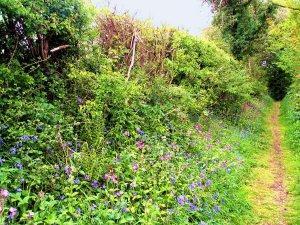
I had my heart very much in my mouth when A Time For Silence was first published, terrified that local people would immediately attack me for painting a false or negative picture. So far, fingers crossed, no one has objected. I did draw heavily on stories people had told me about life in the area and I ploughed through many volumes of old newspapers, to get a feel for how it was, but I still thought people might find my descriptions a bit Gothic. I was surprised, and moved, when several elderly readers told me they recognised their own childhood world in my book. More than moved when one told me she had lived through very similar experiences.
Your second novel Motherlove is also located in Pembrokeshire. What is it about this part of the world that inspires you?
A lot of Motherlove happens a long way from Pembrokeshire, but I think my use of two locations illustrates precisely what inspires me here. The story is about two girls, one, repressed angry Vicky living on a claustrophobic council estate in Lyford, which is my fictional version of Luton, and the other is perfectly contented hippy-child Kelly, living on a small-holding in the Preselis with a couple of goats. Life here can be very liberating – if it’s your choice. There are no real towns so there are no urban pressures. There are very different rural ones instead.
How have you been influenced by other writers in your use of the spirit of the place?
I don’t know that I have been influenced consciously by any other recent writers, but I suppose you could say I’m ever so slightly influenced by the author(s) of the Mabinogion – Mediaeval retellings of pre-Christian myths. This is the area where Pwyll Lord of Dyfed goes hunting and finds himself ruling the Otherworld for a year, where horse-goddesses marry mortals, where warriors live on an island for 80 years with a talking head, where white boars lead you into enchanted mists. This sort of thing doesn’t happen in Luton.
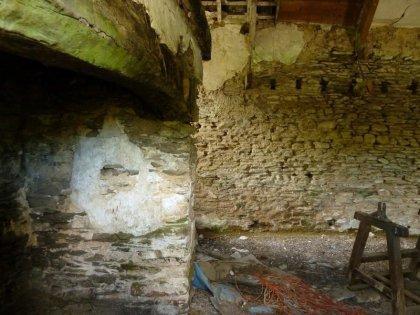
Thank you Booker Talk and Thorne Moore for a fascinating piece on A Time For Silence and Pembrokeshire – I loved the book and since this feature I’ve started it has made me realize just how much authors use their surroundings, varied as they all are, to inspire the novels they write.
Book Reviews from around the Blogosphere
Suze, Likes, Loves, Finds and Dreams
Booker Talk

Now don’t forget to hop over to see Susan at The Book Trail to see the details of the book setting on her wonderful map.
I do hope you’ve enjoyed this visit to Pembrokeshire as much as I have and there are lots more wonderful destinations full of crime coming up on Put A Book On The Map.
A final thank you to Thorne Moore for writing such a brilliantly dark read set in this great destination, I will be reading your other books!
All books featured in this #BookOnTheMap project will get a place on the master page listing crime fiction by their destination with links to the wonderful collaboration between authors and bloggers.
Please email me at [email protected] if you would like to participate in this feature.


